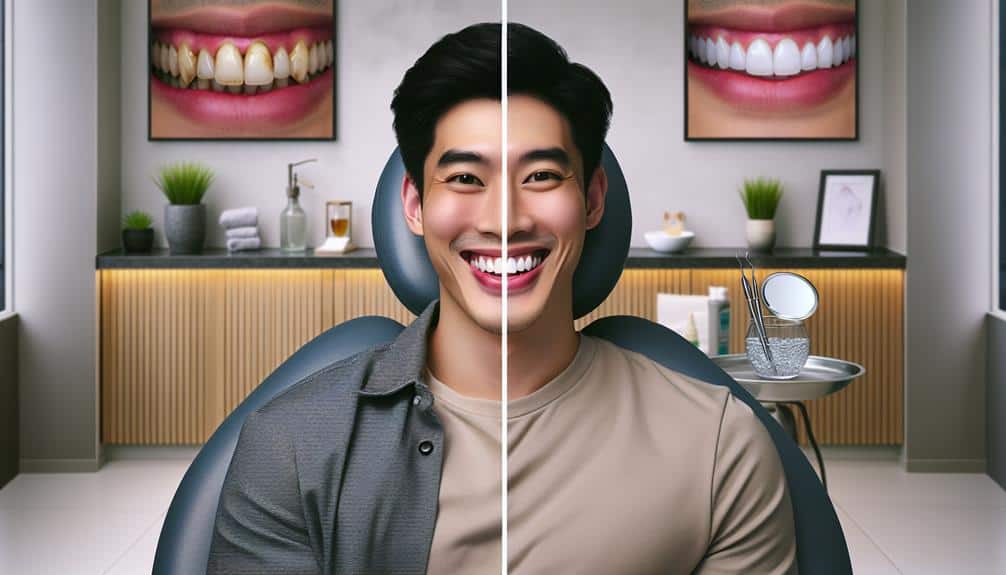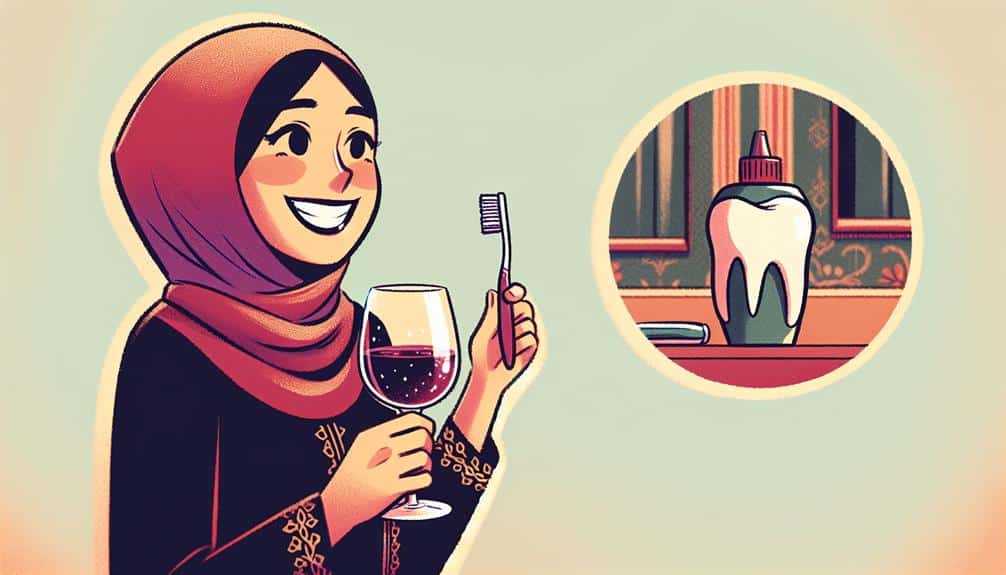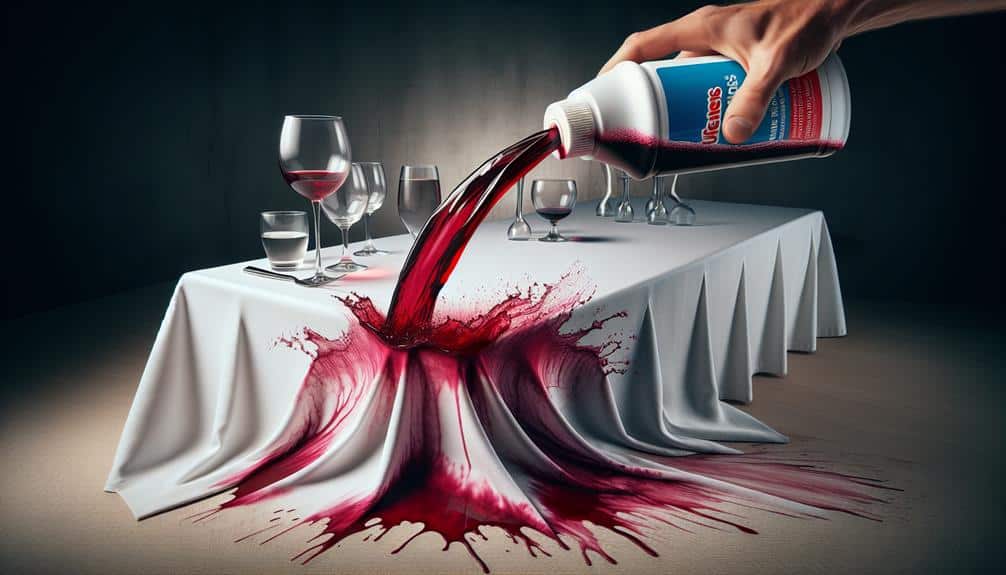Experience state-of-the-art methods to eliminate wine stains from your teeth. Try in-office whitening procedures with high-concentration bleaching agents for rapid results, followed by post-treatment care. Opt for laser whitening treatment to target specific discoloration areas precisely, breaking down chromophores. Professional bleaching techniques, using high hydrogen peroxide concentrations activated by special light, can address deeper stains. Utilize custom tray whitening systems for even gel distribution, offering consistent results over weeks. Combine therapies such as using baking soda and hydrogen peroxide for a thorough approach towards stain removal. Reveal the secrets to restoring your vibrant smile effortlessly.
Key Points
- Laser whitening treatment targets wine stains precisely with laser energy.
- In-office whitening procedures use high-concentration bleaching agents for rapid wine stain removal.
- Custom tray whitening systems provide even gel distribution for wine stain removal.
- Professional bleaching techniques with higher hydrogen peroxide levels effectively remove wine stains.
- Combination therapies integrate various methods to tackle wine stains on teeth effectively.
In-Office Whitening Procedures
To effectively eliminate wine stains on teeth, in-office whitening procedures offer a professional and efficient solution. These procedures involve the application of a bleaching agent, typically hydrogen peroxide or carbamide peroxide, onto the teeth. The high concentration of the whitening agent used in these treatments allows for a more rapid and effective removal of stains compared to over-the-counter products.
After undergoing an in-office whitening procedure, it's important to maintain the results by following specific in-office whitening maintenance and post-treatment care strategies. This includes avoiding foods and beverages that may cause staining, such as red wine, coffee, and tea. Additionally, practicing good oral hygiene habits like brushing and flossing regularly can help prolong the effects of the whitening treatment.
In-office whitening maintenance may also involve periodic touch-up treatments to make sure that your teeth remain bright and stain-free. Your dentist will provide guidance on how often these touch-up treatments are needed based on your individual needs and the level of staining present on your teeth.
Laser Whitening Treatment
Following an in-office whitening procedure, another advanced method for addressing tooth discoloration is through the utilization of laser whitening treatment. Laser technology has revolutionized stain removal by targeting specific areas of discoloration on the teeth. During the procedure, a bleaching agent is applied to the teeth, and a laser is then used to activate the whitening process. The laser energy enhances the effectiveness of the whitening agent, allowing for deeper penetration into the enamel and dentin layers of the tooth.
Laser whitening treatment is known for its precision and efficiency in removing tough stains caused by substances like wine. The focused light energy from the laser breaks down the chromophores responsible for the discoloration, resulting in noticeably whiter teeth. Unlike traditional whitening methods, laser technology can provide quick results in just one session, making it a popular choice for individuals seeking immediate improvements in their smile's appearance.
Professional Bleaching Techniques
Professional bleaching techniques utilize specialized bleaching agents to effectively whiten teeth and remove stubborn stains caused by various factors. These techniques are performed in-office by dental professionals to guarantee maximum bleaching effectiveness. The bleaching agents used in professional treatments contain higher concentrations of hydrogen peroxide compared to over-the-counter products, allowing for more significant color removal.
During the procedure, the bleaching agent is carefully applied to the teeth and activated with a special light or laser to accelerate the whitening process. While professional bleaching can deliver noticeable results in a single session, multiple appointments may be necessary for best outcomes, depending on the severity of the stains.
One common concern associated with professional bleaching is tooth sensitivity. The high concentration of bleaching agents can sometimes lead to temporary sensitivity in the teeth and gums. Dental professionals may recommend desensitizing treatments or adjustments in the bleaching process to minimize discomfort while still achieving desired whitening results.
Custom Tray Whitening Systems
Specialized in-home teeth whitening systems, known as Custom Tray Whitening Systems, offer a convenient and effective way to brighten teeth and combat discoloration. These custom trays are designed to fit your teeth precisely, ensuring even distribution of the whitening gel for best results. The trays are typically worn for a few hours each day over a period of one to two weeks, depending on the level of whitening desired.
Custom Tray Whitening Systems are favored for their ability to provide consistent and noticeable results in the comfort of your own home. They're also reusable, allowing for at-home maintenance of your teeth's brightness. To enhance the whitening effects, some systems may include whitening pens for targeted treatment of stubborn stains or for touch-ups between whitening sessions.
Combination Therapies for Stains
To effectively address stubborn stains on teeth, combining different therapeutic approaches can enhance the overall whitening results. When it comes to combating tough wine stains on teeth, integrating various techniques can lead to more effective outcomes. One approach is to start with professional treatments like custom tray whitening systems to kickstart the whitening process. These systems can reach deep into the enamel and tackle stubborn discoloration.
Following up with home remedies can further enhance the whitening effects. Natural solutions like baking soda or hydrogen peroxide can be used in conjunction with professional treatments to provide an extra boost in removing stains. Baking soda, for instance, acts as a gentle abrasive that helps scrub away surface stains, while hydrogen peroxide has bleaching properties that can lighten deeper discoloration.
Frequently Asked Questions
Are There Any Natural Remedies or DIY Techniques That Can Effectively Remove Wine Stains on Teeth?
To effectively remove wine stains on teeth, natural remedies like baking soda and DIY techniques such as oil pulling can be safe and efficient. These methods help in maintaining oral health and reducing discoloration effectively.
Can Certain Types of Teeth Stains Caused by Wine Be More Difficult to Remove Than Others?
When it comes to wine-induced tooth stains, some types can cling more stubbornly than others. Factors like the pigmentation of wine varietals and the severity of tooth discoloration can make certain stains trickier to remove through dental procedures.
How Long Do the Results of In-Office Whitening Procedures Typically Last When Trying to Remove Wine Stains?
For those seeking lasting effects post in-office whitening for wine stains, consider the long term efficacy achieved through professional recommendations. Maintaining results demands a diligent home care routine. Adhering to recommended methods guarantees prolonged success.
Are There Any Specific Dietary or Lifestyle Changes That Can Help Prevent Wine Stains From Forming on Teeth in the Future?
Want to keep that smile sparkling? Start by making smart choices! Embrace dietary modifications and lifestyle adjustments. Prevent wine stains with strategic prevention techniques and future strategies. Your teeth will thank you!
Are There Any Potential Risks or Side Effects Associated With Using Combination Therapies for Wine Stains on Teeth?
When considering combination therapies for wine stains on teeth, it is crucial to be aware of potential risks and side effects. Long term effects can include enamel damage while immediate concerns may involve tooth sensitivity or gum irritation.


